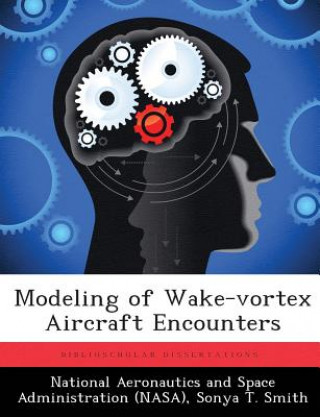
Code: 08286953
Modeling of Wake-vortex Aircraft Encounters
by Sonya T Smith
There are more people passing through the world's airports today than at any other time in history. With this increase in civil transport, airports are becoming capacity limited. In order to increase capacity and thus meet the dem ... more
- Language:
 English
English - Binding: Paperback
- Number of pages: 118
Publisher: Biblioscholar, 2013
- More about this

You might also like
-

Macmillan English Quest Level 4 Teacher's Book Pack
32.69 € -

Sir Martin Mar-All
20.38 € -

Tryal of Lieutenant Colonel John Lilburn. by an Extraordinary or Special Commission, of Oyer and Terminer at the Guild-Hall of London, the 24th, 25th,
22.40 € -

Collection of Acts of the Imperial Parliament
17.25 € -2 % -

Fat of the Land. a Novel.
26.33 € -19 % -

Mirror Lake
104.06 € -
![In the Golden Days. [A Novel.] ... Second Edition. In the Golden Days. [A Novel.] ... Second Edition.](https://media.libris.to/jacket/08048212t.jpg)
In the Golden Days. [A Novel.] ... Second Edition.
27.14 € -18 %
Give this book as a present today
- Order book and choose Gift Order.
- We will send you book gift voucher at once. You can give it out to anyone.
- Book will be send to donee, nothing more to care about.
More about Modeling of Wake-vortex Aircraft Encounters
You get 150 loyalty points
 Book synopsis
Book synopsis
There are more people passing through the world's airports today than at any other time in history. With this increase in civil transport, airports are becoming capacity limited. In order to increase capacity and thus meet the demands of the flying public, the number of runways and number of flights per runway must be increased. In response to the demand, the National Aeronautics and Space Administration (NASA), in conjunction with the Federal Aviation Administration (FAA), airport operators, and the airline industry are taking steps to increase airport capacity without jeopardizing safety. Increasing the production per runway increases the likelihood that an aircraft will encounter the trailing wake-vortex of another aircraft. The hazard of a wake-vortex encounter is that heavy load aircraft can produce high intensity wake turbulence, through the development of its wing-tip vortices. A smaller aircraft following in the wake of the heavy load aircraft will experience redistribution of its aerodynamic load. This creates a safety hazard for the smaller aircraft. Understanding this load redistribution is of great importance, particularly during landing and take-off. In this research wake-vortex effects on an encountering 10% scale model of the B737-100 aircraft are modeled using both strip theory and vortex-lattice modeling methods. The models are then compared to wind tunnel data that was taken in the 30ft x 60ft wind tunnel at NASA Langley Research Center (LaRC). Comparisons are made to determine if the models will have acceptable accuracy when parts of the geometry are removed, such as the horizontal stabilizer and the vertical tail. A sensitivity analysis was also performed to observe how accurately the models could match the experimental data if there was a 10% error in the circulation strength. It was determined that both models show accurate results when the wing, horizontal stabilizer, and vertical tail were a part of the geometry. When the horizontal stabiliz
 Book details
Book details
Book category Books in English Society & social sciences Education
59.95 €
- Full title: Modeling of Wake-vortex Aircraft Encounters
- Author: Sonya T Smith
- Language:
 English
English - Binding: Paperback
- Number of pages: 118
- EAN: 9781288910199
- ISBN: 9781288910199
- ID: 08286953
- Publisher: Biblioscholar
- Weight: 248 g
- Dimensions: 191 × 247 × 10 mm
- Date of publishing: 12. March 2013
Trending among others
-

Cambridge IGCSE (R) & O Level Complete Physics: Student Book Fourth Edition
42.08 € -

Cambridge IGCSE (R) & O Level Complete Biology: Student Book Fourth Edition
42.08 € -

Cambridge IGCSE (R) & O Level Complete Chemistry: Student Book Fourth Edition
51.06 € -

Oxford IB Diploma Programme: IB Economics Course Book
62.27 € -

Oxford IB Diploma Programme: IB Theory of Knowledge Course Book
58.03 € -

Oxford International Primary Science Second Edition: Workbook 4
15.03 € -

Business Partner B1 Workbook
17.65 € -7 % -

CompTIA Security+ Review Guide - Exam SY0-601
24.72 € -24 % -

KS3 Maths 10-Minute Weekly Workouts - Year 8
8.07 € -8 % -

The End of Education
13.41 € -25 % -

English for Nurses Pre-Intermediate Level Book 1
9.58 € -9 % -

Cambridge IGCSE (R) & O Level Complete Biology: Print and Enhanced Online Student Book Pack Fourth Edition
61.26 € -

geog.2 Workbook
11.50 € -6 % -

Oxford IB Study Guides: Economics for the IB Diploma
47.73 € -

Teach Reading With Orton-gillingham
18.76 € -10 % -

KS3 Maths 10-Minute Weekly Workouts - Year 7
8.07 € -8 % -

Blue Book of Grammar and Punctuation: An Easy- to-Use Guide with Clear Rules, Real-World Examples , and Reproducible Quizzes, Twelfth Edition
15.13 € -28 % -

Business Partner B1+ Workbook
16.85 € -3 % -

Powerful Teaching: Unleash the Science of Learning
26.13 € -26 % -

Business Partner B2 Workbook
16.85 € -3 % -

Embodied Teen
21.69 € -16 % -

(ISC) SSCP SG & SSCP Practice Test Kit, 3e
65.09 € -28 % -

Growth Mindset Classroom-ready Resource Book
16.24 € -28 % -

AQA A Level Biology Revision Guide
25.63 € -5 % -

UKCAT For Dummies
23.21 € -28 % -

Oxford International Primary Maths Second Edition: Practice Book 1
12.20 € -

Oxford International Primary Science Second Edition: Student Book 1
26.84 € -

Donny's Unauthorized Technical Guide to Harley Davidson 1936 to Present
48.04 € -16 % -

OET Speaking for Nurses Book 2
11.60 € -2 % -

Edexcel International GCSE Chemistry Student Book Second Edition
31.68 € -14 % -

Oxford International Primary Maths Second Edition: Practice Book 2
12.20 € -

Cambridge IGCSE (R) & O Level Complete Physics: Print and Enhanced Online Student Book Pack Fourth Edition
63.08 € -

Walk Your Talk; Tools and Theories To Share Nonviolent Communication
29.36 € -

OET Speaking For Nurses Book 1
12.81 € -

Oxford International Primary Maths Second Edition: Practice Book 3
13.62 € -

Social Skills Activities for Secondary Students wi th Special Needs, Third Edition
26.33 € -22 % -

AQA GCSE German Foundation Practice Papers
15.33 € -

geog.1 5th edition Workbook Answer Book
56.51 € -

New KS2 English Year 5 Foundation Grammar, Punctuation & Spelling Targeted Question Book w/Answers
8.97 € -5 % -

AQA French A Level Year 1 and AS
50.46 € -

Making Escape Rooms for Educational Purposes
18.76 € -

Cambridge IGCSE (R) & O Level Complete Chemistry: Print and Enhanced Online Student Book Pack Fourth Edition
63.08 € -

New KS2 English Year 4 Foundation Grammar, Punctuation & Spelling Targeted Question Book w/Answers
8.97 € -5 % -

Education in the New Age
12.91 € -

240 Vocabulary Words Kids Need to Know: Grade 3
11.80 € -17 % -

Oxford IB Diploma Programme: Oxford IB Diploma Programme: IB Mathematics: applications and interpretation Standard Level Enhanced Online Course Book
95.38 € -

Oxford International Primary Maths Second Edition: Practice Book 5
16.14 € -

OET Preparation
9.68 € -

Speed and Accuracy: Multiplication
8.57 €
Collection points Bratislava a 2642 dalších
Copyright ©2008-24 najlacnejsie-knihy.sk All rights reservedPrivacyCookies



 15549 collection points
15549 collection points Delivery 2.99 €
Delivery 2.99 € 02/210 210 99 (8-15.30h)
02/210 210 99 (8-15.30h)